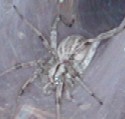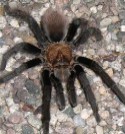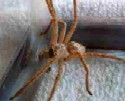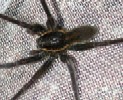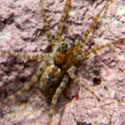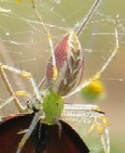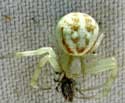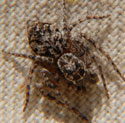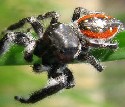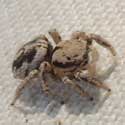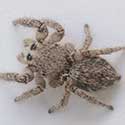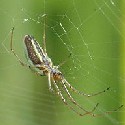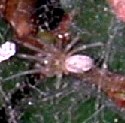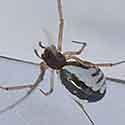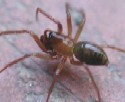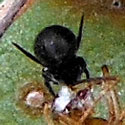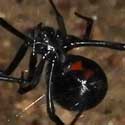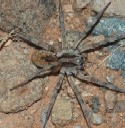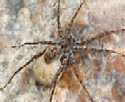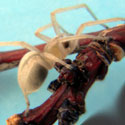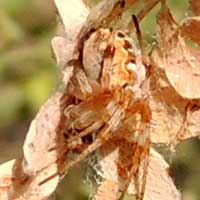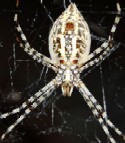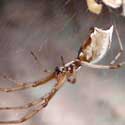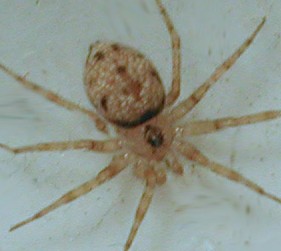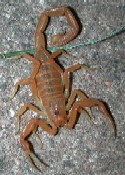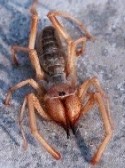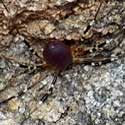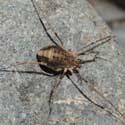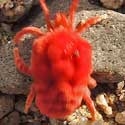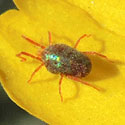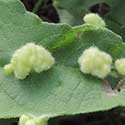Most arachnids have eight legs and one or two main body segments. The head and
thorax are broadly united into a cephalothorax. Mouthparts are chelicerae
(fangs) which generally permit only liquefied food. Many species in the Sonoran
Desert ... only a few are depicted here.
Funnel Spider
Agelenopsis
Medium to large sized spiders that use a trampoline-like sheet
web with a distinct funnel retreat in one corner. Several common species.
More info
|
Desert Tarantula
Aphonopelma sp.
Giant hairy spiders emerging from hidden burrows in late summer. Found walking
along roads and washes.
More info
|
Giant Crab Spider
Olios fasciculatus
Large wandering spiders that can climb walls and ceilings. Long legs and small
eyes. No web.
More info
|
Fishing Spider
Dolomedes triton
Robust spiders with long legs and without a web. Dives into shallow pools to
capture small fish and aquatic insects. Remains near water.
More info
|
Littoral Wolf Spider
Arctosa
Cursorial (running) spiders that hunt on moist sand along flowing desert canyon bottoms.
More info
|
Green Lynx
Peucetia viridens
Large, mostly greenish spiders that hunt on and near flowers without a web.
More info
|
Crab Spider
Mecaphesa
Small to medium sized sit-and-wait predators often on flowers. No snaring web.
Crawls sideways.
More info
|
Lynx Spider
Hamataliwa sp.
Cryptic brown or gray spiders that hunt on trees or shrub bark without a web.
First two pair of legs rotated slightly to face forward.
More info
|
Phidippus Jumping Spider
Phidippus californicus
Active, diurnal spiders that jump after prey. Base color black and marked with
red or salmon.
More info
|
Jumping Spider
Metaphidippus
Off-white marked with black looking like salt and pepper. Roams during day on vegetation.
More info
|
Jumping Spider
Habronatus sp.
Gray jumper hunting on stucco wall in urban Phoenix. The females much drabber than males.
More info
|
Jumping Spider
Colonus sp.
Active, diurnal spiders that do not use a web for prey capture. Instead use
stealth and good vision to hunt prey.
More info
|
Long-jawed Orb Weaver
Tetragnatha sp.
Orb webs suspended above or very close to water. Males have long jaws. Hides
length-wise on grass blades.
More info
|
Dictyna
Dictyna sp.
Small spiders that inhabit dense, tangled webs in the foliage
of shrubs.
More info
|
Bowl and Doily Weaver
Frontinella communis
The basket-shaped web of this spider is a common sight through much of North America.
More info
|
Sheet Web Spider
Linyphiidae
Small spiders that build delicate sheets of silken web often directly on the
soil
More info
|
Tangled Web Spider
Steatoda? sp.
This small spider has its small web suspended below a spine cluster on a cactus.
More info
|
Western Black Widow
Latrodectus mactans
These spiders have potent venom, but the fangs are so small that bites are rare. Strictly nocturnal.
More info
|
Tarantula
Aphonopelma sp.
Other, smaller tarantula species are found in the Sonoran Desert.
More info
|
Wolf Spider
Hogna sp.
Large spiders that hunt at night by roaming around ground surface. Four large
eyes. Rarely climb walls/houses.
More info
|
Long-legged Wolf Spider
Pardosa sp.
Fast-running spiders normally restricted to moist areas near riparian habitats.
Hunts without a web.
More info
|
Southern House Spider
Kukulcania hibernalis
Normally lives within a silken tunnel in a crevice around dwellings. Males have
longer legs and leave webs to search for mates.
More info
|
Long-legged Sac Spider
Cheiracanthium
Fast moving spiders that hunt on vegetation at night and hide in a silken
retreat by day.
More info
|
Orb Weaver
Metepeira sp.
By day the spider hides among a group of leaves. Circlar web is constructed at night and taken down in the morning.
More info
|
Banded Garden Spider
Argiope trifasciata
Large orb-weaving spider. Abdomen tapered to point. Bands on abdomen may be
obscure. Riparian/agricultural areas mostly.
More info
|
Cactus Sheet Web Spider
Diguetia albolineata
Odd-shaped spider hides among a group of leaves tied together at center of irregular web.
More info
|
Wall Spider
Oecobius spp.
Small spiders common inside dwelling. Makes small quarter-sized webs in corners
and textures. Other similar species on shady walls and rock faces.
More info
|
Stripe-tailed Scorpion
Vaejovis spinigerus
Common scorpion found beneath rocks near washes and on mountain slopes. Painful
but not dangerous sting.
More info
|
Giant Hair Scorpion
Hadrurus arizonensis
Largest scorpion in the Sonoran Desert. 'Hairs' require magnification to see.
More info
|
Arizona Bark Scorpion
Centruroides sculpturatus
Most common scorpion found in and around dwellings in the Sonoran Desert.
More info
|
Sun Spider
Eremobates sp.
Fast running and nocturnal. Pinchers in front but no sting. Harmless except for
their small prey.
More info
|
|
Desert Harvestman
Eurybunus ?
Head and abdomen fused. Long slender legs with black and white rings. Body
wine-colored. Wanders at dusk and dawn. No web.
More info
|
Harvestman
Sclerosomatidae ?
Strictly nocturnal, with long legs and not using a web of any kind. Scavengers?
More info
|
Red Velvet Mite
Dinothrombium
After summer rains these bizzare creatures emerge from underground crawling slowly about on the soil.
More info
|
Pavement Mite
Balaustium sp.
Small, bright red mites that run impossibly fast over sidewalks and foliage.
More info
|
Gall Mite
Eriophyidae
Minute to microscopic mites living within plant tissue and causing blister-like
galls.
More info
|
